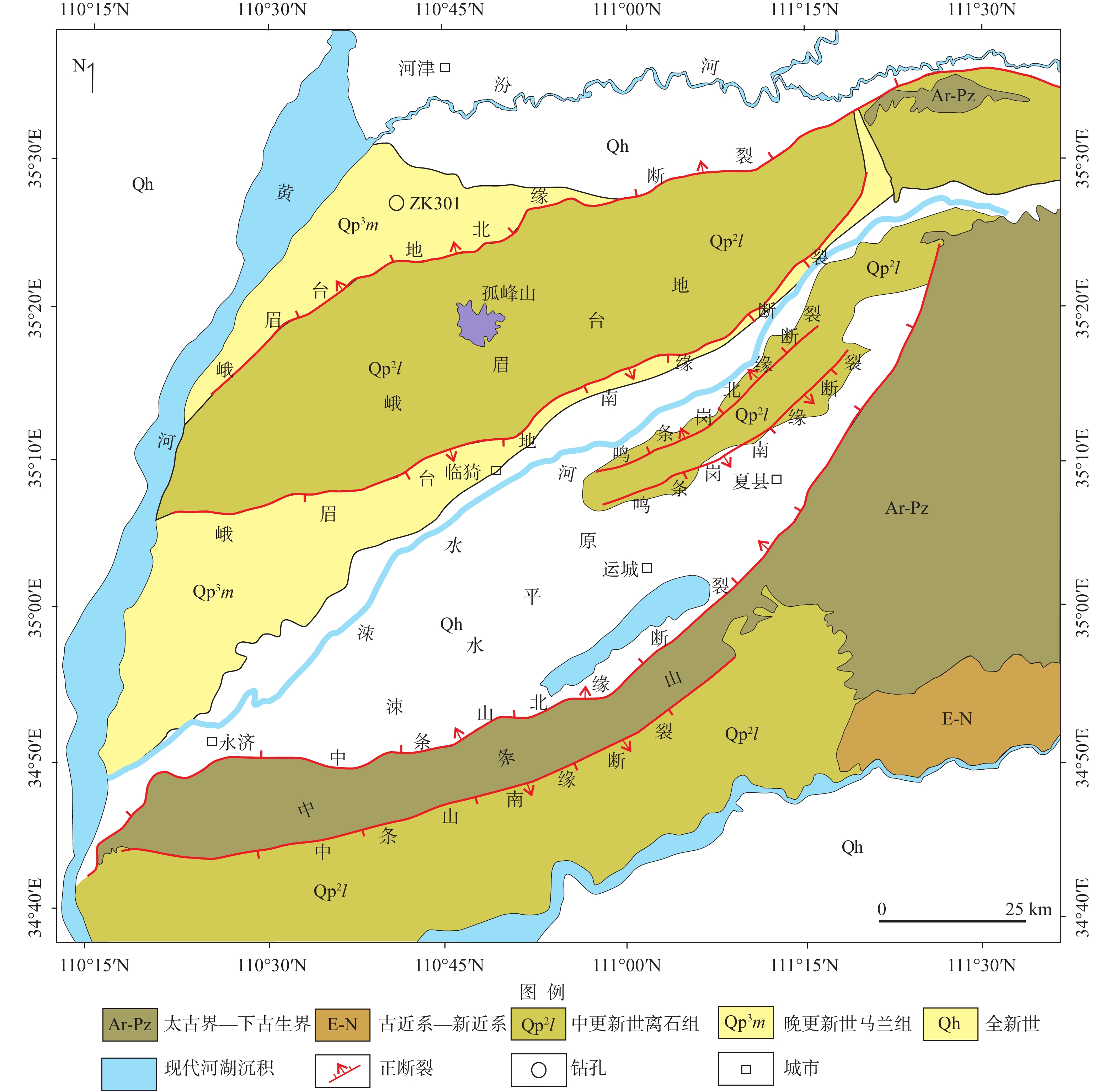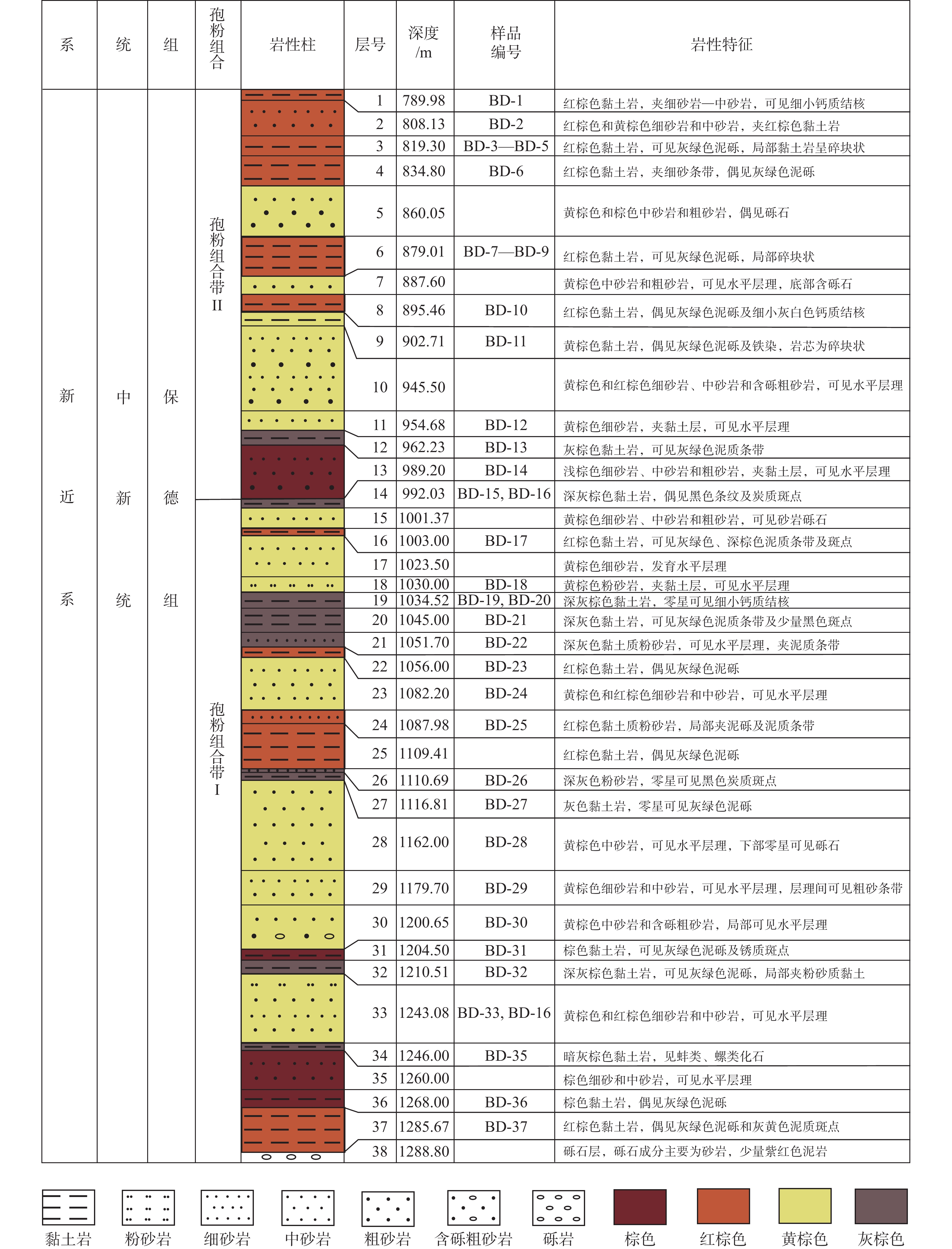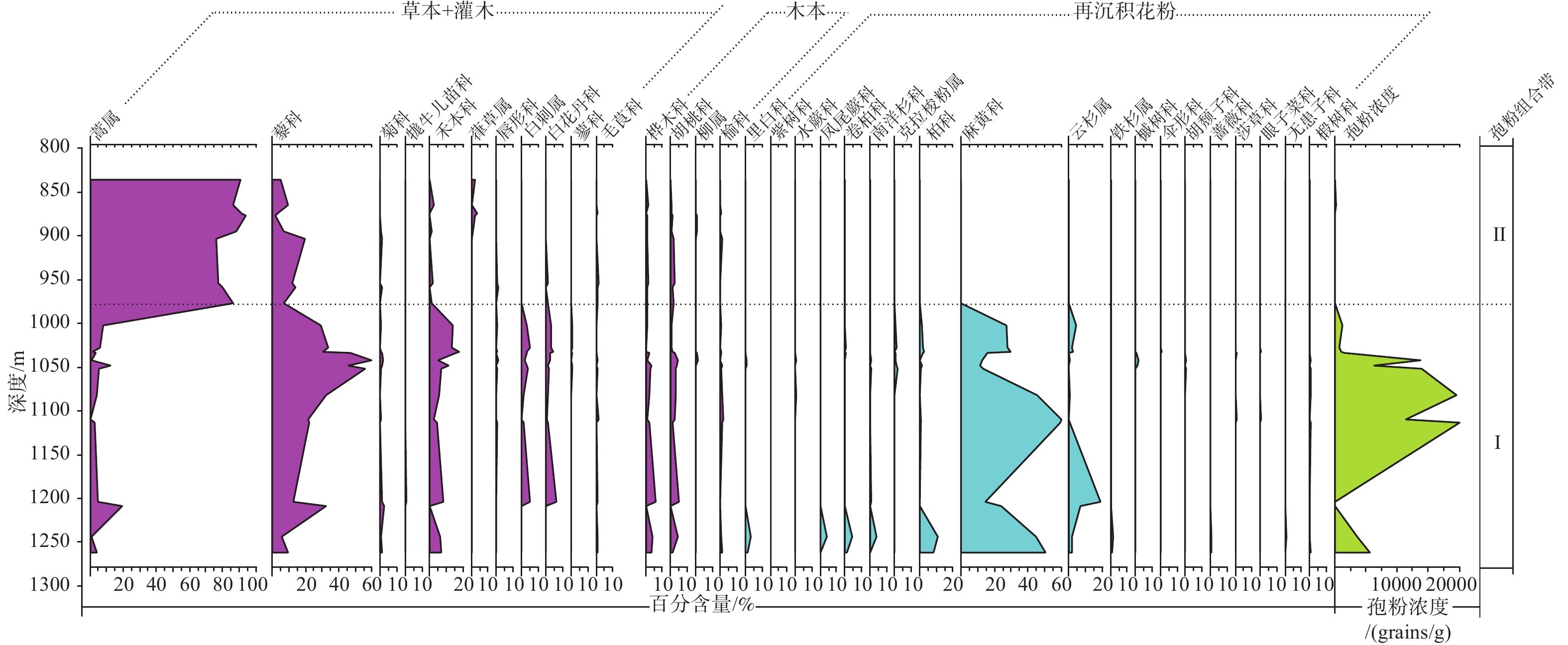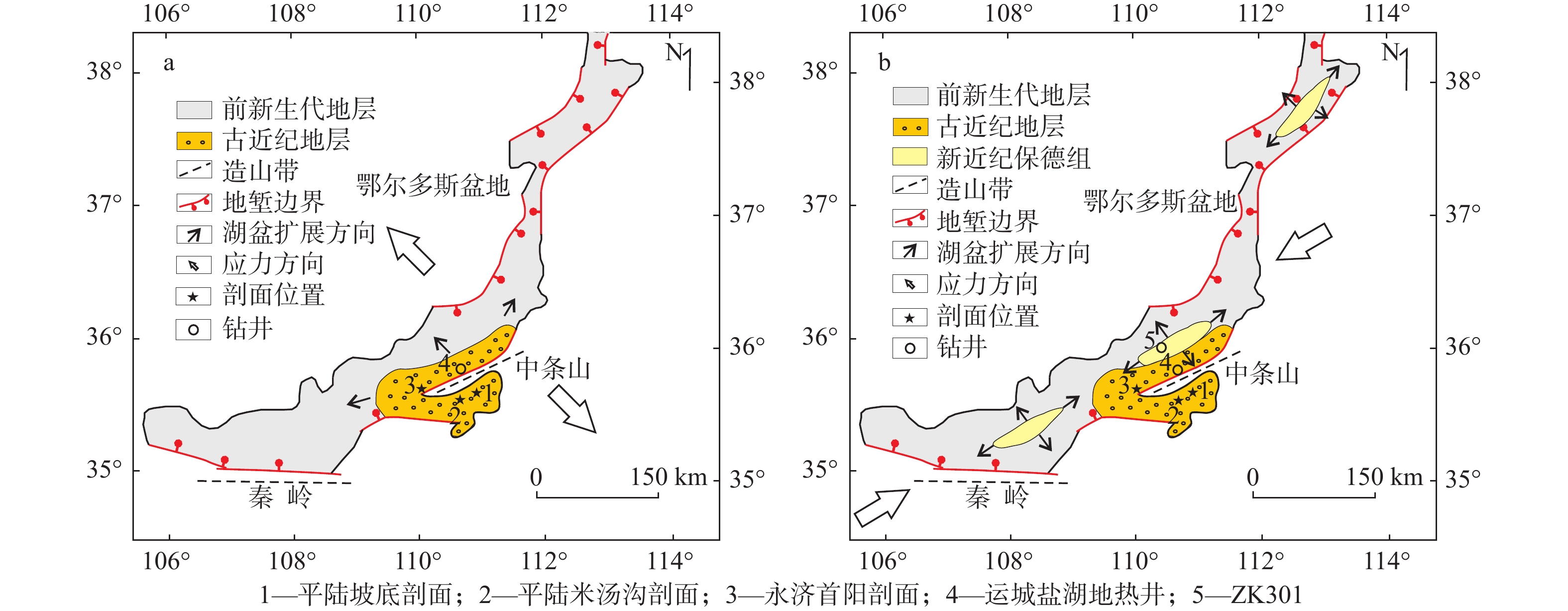The spore-pollen assemblages of the Miocene Baode Formation from Borehole ZK301 in the Yuncheng Basin and its geological significance
-
摘要:
中新世保德组沉积时期是青藏高原向北东方向隆升扩展影响到鄂尔多斯周缘新生代盆地的关键时期。文章对运城盆地峨嵋台地ZK301钻孔中新世晚期保德组岩芯进行了孢粉学研究,系统鉴定了沉积孢粉和再沉积孢粉的特征,探讨了保德组沉积时期的古气候与古构造背景。运城盆地中新世保德组沉积孢粉自下而上可以划分为麻黄科−藜科−禾本科和蒿属−藜科−葎草属2个孢粉组合带,说明运城盆地中新世晚期是从以麻黄科−藜科−禾本科为主的荒漠草原发展为以蒿属−藜科为主的荒漠草原,气候由相对寒冷干燥过渡为偏冷偏干,这种变化过程与中新世晚期青藏高原隆升扩展远程效应对气候的影响有关。再沉积孢粉组合主要集中在保德组下部,以麻黄科含量最高,其次是松属、云杉属、柏科、藜科、胡桃科和蕨类植物孢子,还有少量的克拉梭粉属和胡颓子科等,反映了温暖湿润的气候环境。再沉积孢粉主要来自于中条山北缘山前的古近纪地层,说明在保德组沉积初期,中条山存在一期快速的隆升剥蚀,保德组经历了古近纪地层的剥蚀−搬运−再沉积过程。
Abstract:The deposition period of the Baode Formation in the Miocene was crucial when the uplift and expansion of the Tibetan Plateau in the NE direction affected the Cenozoic basins around the Ordos Plateau. Previous research has mainly focused on tectonic and sedimentary aspects, with relatively few results on climate and environmental responses. We conducted a systematic sporopollen study on the Borehole ZK301 from the late Miocene Baode Formation in the E’mei tableland, Yuncheng Basin, characterized the deposited and redeposited spore-pollen and discussed the paleoclimate and paleotectonic background of the Baode Formation during its deposition. From bottom to top, the Miocene Baode Formation in the Yuncheng Basin can be divided into two spore-pollen assemblages, which are Ephedraceae–Chenopodiaceae–Gramineae zone and Artemisia–Chenopodiaceae–Humulus zone, indicating that the desert steppe dominated by Chenopodiaceae, Gramineae, and Ephedraceae developed into the desert steppe dominated by Artemisia and Chenopodiaceae in the late Miocene. Accordingly, the climate transitioned from relatively cold and dry to cold and dry, which was related to the influence of the remote effect of the uplift and expansion of the Tibetan Plateau on the climate in the late Miocene. The redeposited spore-pollen assemblages are mainly concentrated in the lower part of the Baode Formation, with the highest content of Ephedraceae, followed by Pinus, Picea, Cupressaceae, Chenopodiaceae, Juglandaceae and Pteridophyte, and a small amount of Classopollis and Elaeagnaceae, reflecting a warm and humid climate. The redeposited spore-pollens were mainly from the Paleogene strata on the northern margin of the Zhongtiaoshan Mountains, which indicates that there was a rapid uplift and denudation of the Zhongtiaoshan Mountains in the early stage of the Baode Formation deposition. The Baode Formation underwent the Paleogene strata’s denudation, transportation, and redeposited process. The research results can provide evidence for the late Miocene paleoclimate in the Yuncheng Basin and new evidence for the uplift of the Zhongtiaoshan Mountains in this period.
-
Key words:
- Baode Formation /
- palynological records /
- paleoclimate /
- tectonic implications /
- Yuncheng Basin /
- Cenozoic
-
0. 引言
影响滑坡稳定的因素较多, 且各因素存在复杂性及不确定性, 目前对其研究大多从地形地貌、岩土体性质、岩土体结构面、地下水、地震、工程影响等方面进行分析评价[1~2]。在一定的滑坡工程地质条件下, 有些因素对滑坡失稳影响较大, 而有些则较小, 这就是说, 影响因素对滑坡失稳的贡献是不同的。
滑坡稳定影响因素的敏感性分析就是定量分析影响滑坡稳定性的各因素与滑坡稳定系数之间的相关性, 即分析各因素的变化对于滑坡稳定系数的影响。分析滑坡影响因素的变化与滑坡稳定性的相关关系以及滑坡在不同外界条件下的稳定性, 不但可以找出滑坡失稳的主导因素, 而且根据敏感性分析得出的主要影响因素, 在滑坡治理及优化设计中就可以有针对性的采取相应的整治措施, 使滑坡治理达到安全、经济和有效的目的。因此, 在滑坡及滑坡治理工程中, 影响因素的敏感性分析显得非常重要。
1. 王良寺滑坡概况及其工程地质条件[3]
1.1 滑坡工程概况
王良寺滑坡位于延安市宝塔区桥沟镇东十里铺村, 延河河谷北岸山坡上, 西距延安市中心延河大桥约5.5km, 东临延安飞机场, 南约1km为210国道。
该滑波在延安市宝塔区政府修建的经济适用房场区———又称窑洞小区。窑洞小区投资2亿多元, 共分三期, 其中第一期已交付使用, 在建的第二期工程顺坡台阶式展布, 共六排四列, 多为跃层式别墅房, 少者两层半, 多者四层半, 占地面积100余亩。据现场勘察和走访调查, 第二期工程场地位于一老滑坡体(即王良寺滑坡)上, 其滑坡体体积超过100 × 104m3, 按滑坡规模和物质组成划分, 该滑坡属于大型黄土滑坡。在平场切坡开挖前是稳定的高陡滑坡, 由于第二期工程的大量开挖活动的影响, 改变了滑坡的应力分布, 使滑坡失稳破坏。
1.2 滑坡工程地质条件
1.2.1 地形地貌
滑坡区地貌单元属黄土梁峁斜坡区, 总体由西北向东南延河河谷倾斜, 平均坡降约20.5 %。
1.2.2 地层岩性
根据工程地质测绘及钻探资料, 滑坡岩土体自上而下共分为两个岩土层, 对其特征分述如下:
① 层新黄土(Q3eol):厚15~25m, 滑坡体的主要组成部分, 土质较均, 岩性为粉质粘土, 褐黄~黄褐色, 硬塑~坚硬, 分布有棕褐色古土壤条带, 多含有钙质结核, 直径3~8cm, 局部呈富集状, 孔隙不发育。
② 层老黄土(Q1-2eol):厚20~25m, 多呈黄褐色, 土质均一, 可塑~硬塑, 针状孔隙发育, 含较多钙质结核, 夹杂有棕褐色古土壤层。
1.2.3 水文地质条件
据钻探及井探资料显示, 滑坡区为贫水区, 地下水位埋深较大, 在滑体前缘的井探中发现地下水(据地面8m)。由此可见, 坡体大部分在地下水位以上。地下水主要接受大气降水补给, 以径流方式向延河排泄。
2. 滑坡稳定敏感性分析的计算方法[3]
敏感性分析是系统分析中分析系统稳定的一种方法。对于滑坡系统, 敏感性分析可转化为以滑坡稳定系数FS为考察对象的单指标多因素的显著性分析。本文分析拟采用正交分析法。
单指标多因素的显著性分析可采用线性模型如下:

(1) 式中:β0为常数项; βi为自变量Xi的回归系数; e为随机误差, 服从标准正态分布。
如果在模型中令某些因素的主效应或交互效应为零, 而其余效应的最小二乘估计不受影响, 即与在不假定上述效应为零时所得的估计一致。这保证对每个效应的估计不受到其它效应的影响。则设计矩阵X必须满足如下条件:

(2) 式中:S11、S22、…、Srr都是方阵, 每一块相应于一组效应。
对于某个因素变量Xi对指标Y的显著性次序分析, 不要求做定量结论, 只要求辨明自变量Xi对因变量Y的显著性影响次序。因此无须求解(1)式中的回归系数, 只需按式(2)对各影响因素进行试验设计。此时, 正交试验可满足模型要求。
设A、B、…表示不同的因素; r为各因素水平数; Ai表示因素A的第i水平(i =1, 2, L, r); Xij表示因素j的第i水平的值(i =1, 2, L, r; j =A, B, L)。
在Xij下进行试验得到因素j第i水平的试验结果指标Yij, Yij是服从正态分布的随机变量。在Xij下做了n次试验得到n个试验结果, 分别为Yijk (k =1, 2, L, n)。有计算参数如下:

(3) 式中:Kij为因素j在i水平下的统计参数; n为因素j在i水平下的试验次数; Yijk为因素j在i水平下第k个试验结果指标值。
评价因素显著性的参数为极差Rj, 其计算公式如下:

(4) 极差越大说明该因素的水平改变对试验结果影响也越大。极差最大的因素也就是最主要的因素, 极差较小的因素为较次要的因素, 依此类推。
利用正交分析法可以解决以下几个问题:
(1) 分清各因素对指标影响的主次顺序, 即分清哪些是主要因素, 哪些是次要因素;
(2) 找出优化的设计方案, 即考察的每个因素各取什么水平才能达到试验指标的要求;
(3) 分析因素与指标间的关系, 即当因素变化时指标是怎样变化的, 找出指标随因素的变化规律和趋势。
3. 滑坡稳定敏感性分析
3.1 正交试验设计
王良寺滑坡稳定系数的计算, 采用圆弧条分法中的简化Bishop法[4]。在对其进行正交试验设计时, 考虑的因素主要有粘聚力(c)、内摩擦角(φ)、重度(γ)、地下水位(hw)、坡高(h)等5种参数变化。各影响因素分析均只考虑土体参数的自相关性, 不考虑其的互相关性影响。为了减少由于水平次序引起的系统误差, 各因素水平的次序应随机排列。参数取值范围和按抽签方式确定的因素水平次序如表 1所示。
表 1 各参数取值范围Table 1. The range of each parameter
假设各因素间无交互作用, 可选5因素正交表安排试验。对于4水平5因素正交试验, 最少试验次数为16次, 记为L16 (45)。
3.2 计算结果分析
选用数理统计L16 (45)正交表[5], 按表 1确定的试验方案, 对王良寺滑坡进行以稳定系数为指标的多因素显著性计算分析。正交试验因素水平概化值及计算结果如表 2所示。
表 2 正交试验计算结果Table 2. Results of orthogonality test
对于因素γ, 它的第一水平(γ=16)下的4次计算(表 2中试验号1, 2, 3, 4)求得的稳定系数之和K1j=3.955;第二水平(γ=18)下的4次计算(试验号5, 6, 7, 8)求得的稳定系数之和K2j =3.825;依此类推, 如表 3。
表 3 不同重度值的稳定性系数Table 3. Stability coefficient of different weights
对于因素c, 它的第一水平(c =57)下的4次计算(表 2中试验号1, 5, 9, 13)求得的稳定系数之和K1 j =4.417;第二水平(c =43)下的4次计算(试验号2, 6, 10, 14)求得的稳定系数之和K2j =3.891;依此类推, 如表 4。
表 4 不同粘聚力的稳定性系数Table 4. Stability coefficient of different cohesive forces
用同样的方法计算φ、h、hw相应的稳定系数之和K1j、K2j、K3j、K4j, 如表 5、表 6、表 7。
表 5 不同内摩擦角的稳定性系数Table 5. Stability coefficient of different internal friction angles 表 6 不同坡高的稳定性系数Table 6. Stability coefficient of different slope heights
表 6 不同坡高的稳定性系数Table 6. Stability coefficient of different slope heights 表 7 不同地下水位的稳定性系数Table 7. Stability coefficient of different groundwater levels
表 7 不同地下水位的稳定性系数Table 7. Stability coefficient of different groundwater levels
各参数的极差分析如表 8所示。
表 8 各参数极差分析Table 8. Range analysis of parameters
正交试验设计中各因素不同水平之间的搭配是均衡的, 例如根据因素γ的4种不同水平分成的4组计算的每一组计算中, c、φ等其他因素的不同水平皆出现一次。因此γ的K1j、K2j、K3j、K4j之间的差异可以认为主要是γ取不同水平造成的。同理, 哪个因素的极差R大, 就可以认为该因素水平不同对滑坡稳定性产生的影响就大, 影响最大的因素即最敏感因素。从表 8中的极差值可以看出, φ是最敏感的因素, 其他依次为c、hw、γ、h。
4. 滑坡治理措施探讨
王良寺滑坡为一大型黄土老滑坡因不适当开挖引发复活, 滑坡后部宽约130m, 前部宽约270m, 南北长约350m。坡体中部及前部为拟建的经济适用窑小区, 8排24幢房屋, 建成后将有千余人入住, 依据《建筑边坡工程技术规范》 (GB05330-2002), 其安全等级为Ⅱ级。
根据滑坡稳定影响因子敏感性分析结果, 本工程采用上部截排地表水、滑体后部推力段依势适当削坡、下部抗滑桩支挡三种工程相结合的综合治理措施。抗滑桩位置的选择既考虑坡体的整体稳定又能防止坡体的局部剪出。
4.1 截、排水工程
上部截水沟在滑坡后壁后侧, 依滑坡后壁走势布置, 内截面倒梯形, 长度约400m, 排水沟纵向坡率为3 ‰, 水沟材料采用浆砌片石, 等级为M10。
4.2 削坡、护坡工程
削坡工程充分利用黄土局部直立性能好的特点, 分级削坡, 每级坡高为10m, 坡比为1: 1.5, 共5级, 两级削坡间设3m宽平台。部分削坡土方回填于下部抗滑桩后, 既减少土方运距又可适当压脚。护坡工程采用2m ×2m尺寸的菱形网格格构, 格体采用M10浆砌片石构筑, 截面尺寸为300mm×400mm。
4.3 支挡工程
支挡工程采用半悬臂式抗滑桩。设计中采用的土体力学参数为:滑面以上土体重度γ= 16kN/m3, 粘聚力c =31kPa, 内摩擦角φ=23°; 滑体后部滑动带土体重度γ=18kN/m3, 粘聚力c =25kPa, 内摩擦角φ=18°; 滑面以下土体重度为γ=18kN/m3, 粘聚力c =31kPa, 内摩擦角φ=23°。取边坡稳定安全系数为1.25, 采用圆弧滑动法计算, 滑面以上适当考虑桩前土的抗力作用, 桩后剩余下滑力和桩前土抗力均按矩形分布, 滑面下按弹性地基梁计算, 地基水平抗力系数m=2000kN/m4。设计抗滑桩截面尺寸为2.5m×3.5m, 中至中间距为6m。
5. 结论
采用概率统计原理和计算机电算技术的正交分析法对滑坡稳定影响因子进行敏感性分析, 其工作量小、易于完成, 具有一定的通用性, 对工程技术人员来说是一种较实用的分析方法。实例分析表明, 运用正交分析法得到的结论与一般工程经验相符, 因此该方法具有一定的可靠性。
本文在对滑坡稳定性影响因子进行敏感性分析时, 没有考虑参数的相关性对其稳定性的影响, 在今后的工作可以考虑改进正交分析法以进行因素间有交互作用时的分析。实际上岩土体参数c、φ通常呈负相关性, 考虑参数的相关性可以使稳定性分析模型更接近于工程实际, 提高对滑坡稳定系数的计算精度, 以期达到安全、可靠, 经济、合理的治理效果。
-
图 3 ZK301钻孔中新世晚期保德组主要孢粉类型(比例尺均为10 μm)
1—蒿属;2—蓝刺头属;3—藜科;4—麻黄科;5—白刺属;6—白花丹科;7—禾本科;8—葎草属;9—蓼科;10—毛茛科;11—牻牛儿苗科;12—伞形科;13—莎草科;14—眼子菜科;15—槭树科;16—桦木科;17—胡桃科;18—柳属;19—椴树科;20—榆科;21—苏铁科;22—铁杉属;23—松属
Figure 3. Photomicrographs of selected spore-pollen types from the late Miocene Baode Formation from Borehole ZK301 (The scale is 10 μm)
(1) Artemisia; (2) Echinops; (3) Chenopodiaceae; (4) Ephedraceae; (5) Nitraria; (6) Plumbaginaceae; (7) Gramineae; (8) Humulus; (9) Polygonaceae; (10) Ranunculaceae; (11) Geraniaceae; (12) Apiaceae; (13) Cyperaceae; (14) Potamogetonaceae; (15) Aceraceae; (16) Betulaceae; (17) Juglandaceae; (18) Salix; (19) Tiliaceae; (20) Ulmaceae; (21) Cycadaceae; (22) Tsuga; (23) Pinus
图 4 ZK301钻孔中新世晚期保德组主要再沉积孢粉类型(比例尺均为10 μm)
1—里白科;2—凤尾蕨科;3—卷柏科;4—紫萁科;5—水蕨科;6—克拉梭粉属;7—胡桃科:山核桃属;8—胡桃科:黄杞属;9—藜科;10—胡颓子科;11—麻黄科:梭形麻黄粉;12—麻黄科:多肋麻黄粉;13—柏科;14—南洋杉科;15—铁杉属;16—松属;17—云杉属
Figure 4. Photomicrographs of selected redeposited spore-pollen types of the late Miocene Baode Formation from Borehole ZK301 (The scale is 10 μm)
(1) Gleicheniaceae; (2) Pteridaceae; (3) Selaginellaceae; (4) Osmundaceae; (5) Parkeriaceae; (6) Classopollis; (7) Juglandaceae: Carya; (8) Juglandaceae: Engelhardtia; (9) Chenopodiaceae; (10) Elaeagnaceae; (11) Ephedraceae: Ephedripites fusiformis; (12) Ephedraceae: Ephedripites multicotatus; (13) Cupressaceae; (14) Araucariaceae; (15) Tsuga; (16) Pinus; (17) Picea
-
[1] CHEN X Q, 2017. Sedimentary and tectonic evolution of the Cenozoic Weihe-Shanxi Graben and the mechanism [D]. Doctor's thesis. Beijing: Peking University. (in Chinese with English abstract) [2] CHEN X Q, DONG S W, SHI W, et al. , 2021. Magnetostratigraphic ages of the Cenozoic Weihe and Shanxi Grabens in North China and their tectonic implications[J]. Tectonophysics, 813: 228914. doi: 10.1016/j.tecto.2021.228914 [3] China Vegetation Editing Committee, 1980. China vegetation[M]. Beijing: Science Press. (in Chinese) [4] DENG T, WANG W M, YUE L P, et al. , 2004. New advances in the establishment of the Neogene Baode stage[J]. Journal of Stratigraphy, 28(1): 41-47. (in Chinese with English abstract) [5] DENG T, WANG W M, YUE L P, 2008. A comprehensive study report on the Shanwang and Baode stages of the Neogene in China[M]. In: Third National Stratigraphic Commission, ed. Research Report on the Stratigraphic Formation of Major Faults in China (2001~2005). Beijing: Geology Press, 13-31. (in Chinese) [6] FANG X M, 2017. Phased uplift of the Tibetan Plateau[J]. Science & Technology Review, 35(6): 42-50. (in Chinese with English abstract) [7] GRUBOV V I, 2001. Key to the vascular plants of Mongolia (with an Atlas)[M]. Science Publishers. [8] HAN X M, LIU F, ZHANG W T, et al. , 2015. Analyzing the variation characteristics of stress field in Hetao seismic belt using focal mechanism data[J]. Seismology and Geology, 37(4): 1030-1042. (in Chinese with English abstract) [9] KOU L L, LI Z H, DONG X P, et al. , 2021. The age sequence of the detrital zircons from the Guanyindian section in Longde, the northeastern margin of the Tibetan Plateau, and its geological significance[J]. Journal of Geomechanics, 27(6): 1051-1064. (in Chinese with English abstract) [10] LI S Z, CAO X Z, WANG G Z, et al. , 2019. Meso-Cenozoic tectonic evolution and plate reconstruction of the Pacific Plate[J]. Journal of Geomechanics, 25(5): 642-677. (in Chinese with English abstract) [11] LI W Y, 1998. Quaternary vegetation and environment of China[M]. Beijing: Science Press. (in Chinese) [12] LI X R, FANG X M, WU F L, et al. , 2011. Pollen evidence from Baode of the northern Loess Plateau of China and strong East Asian summer monsoons during the Early Pliocene[J]. Chinese Science Bulletin, 56(1): 64-69. doi: 10.1007/s11434-010-4235-8 [13] LI Y W, XU Q H, ZHANG S R, et al. , 2019. Significance of pollen assemblages for the vegetationcomposition of alpine shrub meadow in the Qinghai-Tibetan Plateau, China[J]. Chinese Science Bulletin, 64(20): 2141-2150. (in Chinese with English abstract) doi: 10.1360/N972019-00126 [14] LI Z H, JIANG B Y, DONG X P, et al. , 2020. Collapses of loess at the front of the Emei tableland in the Yuncheng basin and their major geological controlling factors[J]. Coal Geology & Exploration, 48(2): 171-178. (in Chinese with English abstract) [15] LIN X D, YUAN H Y, XU P, et al. , 2017. Zonational characteristics of earthquake focal mechanism solutions in North China[J]. Chinese Journal of Geophysics, 60(12): 4589-4622. (in Chinese with English abstract) [16] LIU Z S, 2000. Early cretaceous sporopollen assemblage from the Hanxia of Yumen in Gansu, NW China[J]. Acta Micropalaeontologica Sinica, 17(3): 73-84. (in Chinese with English abstract) [17] LUO C X, PAN A D, ZHENG Z, 2006. Progresses about the studies on the relationship between topsoil spore-pollen and vegetation in arid areas of northwest China[J]. Arid Zone Research, 23(2): 314-319. (in Chinese with English abstract) [18] MINCKLEY T, WHITLOCK C, 2000. Spatial variation of modern pollen in Oregon and southern Washington, USA[J]. Review of Palaeobotany and Palynology, 112(1-3): 97-123. doi: 10.1016/S0034-6667(00)00037-3 [19] MOLNAR P, 2005. Mio-Pliocene growth of the Tibetan Plateau and evolution of East Asian climate[J]. Palaeontologia Electronica, 8(1): 1-23. [20] National Stratigraphic Committee, 1963. Cenozoic erathem of China[M]. Beijing: Science Press. (in Chinese) [21] Palynological Section, Morphological Department, Institute of Botany, Chinese Academy of Sciences, 1960. Pollen morphology of Chinese plants[M]. Beijing: Science Press. (in Chinese) [22] POKROVSKAYA, GESHIDEKOVA, GRICHUK, et al. , 1956. Pollen analysis[M]. WANG F X, ZHANG J T, MA Y Q, et al, trans. Beijing: Science Press. (in Chinese) [23] QI Y, XU H B, ZHANG J X, et al. , 2011. Geochemistry, geochronology and geological significance of Gufengshan granodiorite in Linfen Grabben Basin[J]. Geological Review, 57(4): 565-573. (in Chinese with English abstract) [24] QI Y, LUO J H, WU J D, et al. , 2016. Geochemical and Sr-Nd-Pb isotopic composition of the Canfang and Gufengshan granodiorite plutons in central-southern North China[J]. Acta Petrologica Sinica, 32(7): 2015-2028. (in Chinese with English abstract) [25] QIN B C, FANG W X, ZHANG J G, et al. , 2021. Quaternary sedimentary sequence and sedimentary environment restoration in the Jinzhong Basin, Fenhe Rift Valley[J]. Journal of Geomechanics, 27 (6): 1035-1050. (in Chinese with English abstract) [26] QIU D W, GONG W B, YAN J Y, et al. , 2021. Geological environment changes during the late Pleistocene-Holocene on the E'mei tableland in the northern Yuncheng basin, Shanxi Province: implications for the distribution of human settlements[J]. Journal of Geomechanics, 27(2): 326-338. (in Chinese with English abstract) [27] SCHÄBITZ F, 1994. Holocene climatic variations in northern Patagonia, Argentina[J]. Palaeogeography, Palaeoclimatology, Palaeoecology, 109(2-4): 287-294. doi: 10.1016/0031-0182(94)90180-5 [28] Shanxi Provincial Geological Bureau 214 Geological Team, 1982. Instructions for 1: 100000 Geological Map of Yuncheng District, Shanxi Province[M]. Yuncheng: Water Resources Bureau of Yuncheng District Administration. (in Chinese) [29] Shanxi Provincial Geological Prospecting Bureau, 1989. Regional geology of Shanxi province[M]. Beijing: Geology Press. (in Chinese) [30] SHI W, DONG S W, HU J M, 2020. Neotectonics around the Ordos Block, North China: a review and new insights[J]. Earth-Science Reviews, 200: 102969. doi: 10.1016/j.earscirev.2019.102969 [31] SONG Z C, 1999. Fossil spores and pollen of China (Vol. 1)[M]. Beijing: Science Press. (in Chinese) [32] Sporopollen Group, Paleobotany Research Office, Beijing Institute of Botany, Chinese Academy of Sciences, 1976. Spore morphology of ferns in China[M]. Beijing: Science Press. (in Chinese) [33] SU P, HE H L, TAN X B, et al, 2021. Initiation and evolution of the Shanxi rift system in North China: evidence from low-temperature thermochronology in a plate reconstruction framework[J]. Tectonics, 40(3): e2020TC006298. [34] SUO Y H, LI S Z, CAO X Z, et al. , 2017. Mesozoic-Cenozoic inversion tectonics of East China and its implications for the subduction process of the oceanic plate[J]. Earth Science Frontiers, 24(4): 249-267. (in Chinese with English abstract) [35] TONG Y S, ZHENG S H, QIU Z D, 1995. Cenozoic mammals ages of China[J]. Vertebrata Palasiatica, 33(4): 290-314. (in Chinese with English abstract) [36] XU Q H, LI Y C, YANG X L, et al. , 2005. A study of some typical pollen types taphonomy and relationships with vegetation in the northeast of Qinghai-Tibet Plateau[J]. Advances in Earth Science, 20(1): 89-98. (in Chinese with English abstract) [37] XU Q H, LI Y C, YANG X L, et al. , 2007. Quantitative relationship between pollen and vegetation in northern China[J]. Science in China Series D: Earth Sciences, 50(4): 582-599. doi: 10.1007/s11430-007-2044-y [38] XU Z L, 2015. Oligocene-Miocene pollen records in Xunhua Basin, northeastern Tibetan Plateau and its implications for evolution of the East Asian monsoon[D]. Wuhan: China University of Geosciences. (in Chinese with English abstract) [39] YAN J Y, 2021. Late Cenozoic tectonic-sedimenatary, uplifting and denudational process of the Yuncheng Basin and northern Gushan Mountain[D]. Beijing: Chinese Academy of Geological Sciences. (in Chinese with English abstract) [40] YAN S, 1991. The characteristics of Quaternary sporo-pollen assemblage and the vegetation succesion in Xinjiang[J]. Arid Land Geography, 14(2): 1-9. (in Chinese with English abstract) [41] ZDANSKY O, 1923. Fundorte der Hipparion-Fauna um Pao-Te-Hsien in NW-Shansi[J]. Bulletin of the Geological Survey, China, 5: 69-81. [42] ZHANG Y X, YUE L P, CHEN D L, et al. , 1997. Petrographic marks for stratigraphic division of the Neogene Red Clay in North China and their significance[J]. Journal of Stratigraphy, 21(1): 63-67. (in Chinese with English abstract) [43] ZHONG Q M, SHAO B, HOU G T, 2022. Numerical simulation and analysis of lithospheric stress field in Fenwei graben[J]. Progress in Geophysics, 37(1): 152-163. (in Chinese with English abstract) [44] 陈兴强, 2017. 汾渭地堑系新生代沉积-构造演化及其形成机制[D].博士学位论文.北京: 北京大学. [45] 邓涛, 王伟铭, 岳乐平, 等, 2004. 新近系保德阶建阶研究新进展[J]. 地层学杂志, 28(1): 41-47. [46] 邓涛, 王伟铭, 岳乐平, 2008. 中国陆相新近系山旺阶和保德阶综合研究报告[M]. 见: 第三届全国地层委员会编. 中国主要断代地层建阶研究报告(2001~2005). 北京: 地质出版社, 13-31. [47] 方小敏, 2017. 青藏高原隆升阶段性[J]. 科技导报, 35(6): 42-50. [48] 韩晓明, 刘芳, 张文韬, 等, 2015. 基于震源机制资料分析河套地震带的应力场变化特征[J]. 地震地质, 37(4): 1030-1042. [49] 寇琳琳, 李振宏, 董晓朋, 等, 2021. 青藏高原东北缘隆德观音店剖面碎屑锆石年龄序列及地质意义[J]. 地质力学学报, 27(6): 1051-1064. [50] 李三忠, 曹现志, 王光增, 等, 2019. 太平洋板块中-新生代构造演化及板块重建[J]. 地质力学学报, 25(5): 642-677. [51] 李文漪, 1998. 中国第四纪植被与环境[M]. 北京: 科学出版社. [52] 李怡雯, 徐海清, 张生瑞, 等, 2019. 青藏高原高寒灌丛草甸花粉组合的植被指示性[J]. 科学通报, 64: 2141-2150. [53] 李振宏, 姜博宇, 董晓朋, 等, 2020. 运城盆地峨眉台地前缘黄土塌陷现状及地质主控因素[J]. 煤田地质与勘探, 48(2): 171-178. [54] 林向东, 袁怀玉, 徐平, 等, 2017. 华北地区地震震源机制分区特征[J]. 地球物理学报, 60(12): 4589-4622. [55] 刘兆生, 2000. 甘肃玉门旱峡早白垩世孢粉组合[J]. 微体古生物学报, 17(3): 73-84. [56] 罗传秀, 潘安定, 郑卓, 2006. 西北干旱地区表土孢粉与植被关系研究进展[J]. 干旱区研究, 23(2): 314-319. [57] 坡克罗夫斯卡娅, 格刺德科娃, 格里丘克, 等, 1956. 花粉分析[M]. 王伏雄, 张金谈, 马毓泉, 等译. 北京: 科学出版社. [58] 齐玥, 徐鸿博, 张竞雄, 等, 2011. 临汾断陷盆地孤峰山花岗闪长岩的地球化学和年代学及其地质意义[J]. 地质论评, 57(4): 565-573. [59] 齐玥, 罗金海, 巫嘉德, 等, 2016. 华北中南部蚕坊和孤峰山花岗闪长岩体的地球化学特征和Sr-Nd-Pb同位素组成[J]. 岩石学报, 32(7): 2015-2028. [60] 秦帮策, 方维萱, 张建国, 等, 2021. 汾河裂谷晋中盆地内第四纪沉积序列与沉积环境恢复[J]. 地质力学学报, 27 (6): 1035-1050. [61] 仇度伟, 公王斌, 闫纪元, 等, 2021. 山西运城盆地北部峨嵋台地晚更新世: 全新世地质环境变化及其对人类聚落分布的影响[J]. 地质力学学报, 27(2): 326-338. [62] 全国地层委员会, 1963. 全国地层会议学术报告汇编: 中国的新生界[M]. 北京: 科学出版社. [63] 山西省地质局二一四地质队, 1982. 山西省运城地区地质图系说明书[M]. 运城: 运城地区行署水利局. [64] 山西省地质矿产局, 1989. 山西省区域地质志[M]. 北京: 地质出版社. [65] 宋之琛, 1999. 中国孢粉化石(第一卷): 晚白垩世和第三纪孢粉[M]. 北京: 科学出版社. [66] 索艳慧, 李三忠, 曹现志, 等, 2017. 中国东部中新生代反转构造及其记录的大洋板块俯冲过程[J]. 地学前缘, 24(4): 249-267. [67] 童永生, 郑绍华, 邱铸鼎, 1995. 中国新生代哺乳动物分期[J]. 古脊椎动物学报, 33(4): 290-314. [68] 许清海, 李月丛, 阳小兰, 等, 2005. 青藏高原东北部典型花粉类型埋藏特征及其与植被关系的研究[J]. 地球科学进展, 20(1): 89-98. [69] 徐增连, 2015. 青藏高原东北缘循化盆地渐新世-中新世孢粉记录与东亚季风演化[D]. 武汉: 中国地质大学. [70] 闫纪元, 2021. 运城盆地及北侧孤山晚新生代构造-沉积与隆升-剥蚀过程研究[D]. 北京: 中国地质科学院. [71] 闫顺, 1991. 新疆第四纪孢粉组合特征及植被演替[J]. 干旱区地理, 14(2): 1-9. [72] 张云翔, 岳乐平, 陈丹玲, 等, 1997. 中国北部新第三纪红层划分的岩石学标志及其意义[J]. 地层学杂志, 21(1): 63-67. [73] 中国科学院北京植物研究所古植物研究室孢粉组, 1976. 中国蕨类植物孢子形态[M]. 北京: 科学出版社. [74] 中国科学院植物研究所形态室孢粉组, 1960. 中国植物花粉形态[M]. 北京: 科学出版社. [75] 中国植被编辑委员会, 1980. 中国植被[M]. 北京: 科学出版社. [76] 仲启蒙, 邵博, 侯贵廷, 2022. 汾渭地堑岩石圈的应力场数值模拟与分析[J]. 地球物理学进展, 37(1): 152-163. -





 下载:
下载:

 下载:
下载:






